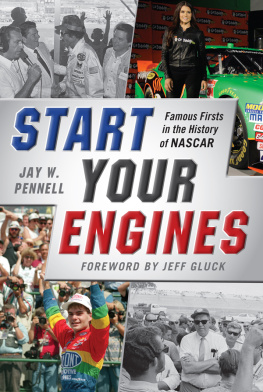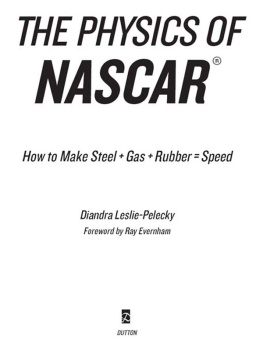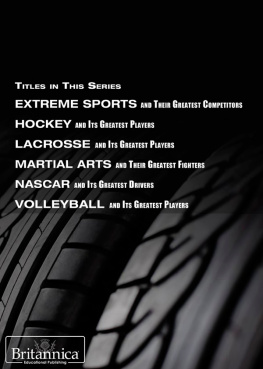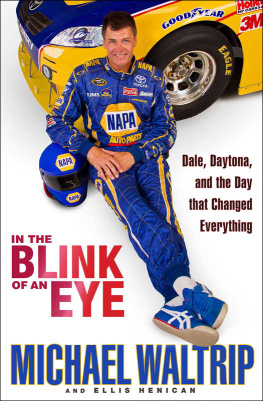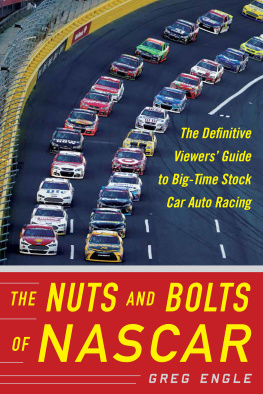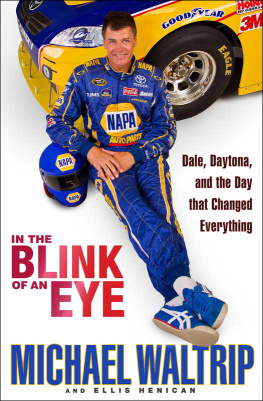Copyright 2015 by Jay W. Pennell
All rights reserved. No part of this book may be reproduced in any manner without the express written consent of the publisher, except in the case of brief excerpts in critical reviews or articles. All inquiries should be addressed to Sports Publishing, 307 West 36th Street, 11th Floor, New York, NY 10018.
Sports Publishing books may be purchased in bulk at special discounts for sales promotion, corporate gifts, fund-raising, or educational purposes. Special editions can also be created to specifications. For details, contact the Special Sales Department, Sports Publishing, 307 West 36th Street, 11th Floor, New York, NY 10018 or .
Sports Publishing is a registered trademark of Skyhorse Publishing, Inc., a Delaware corporation.
Visit our website at www.sportspubbooks.com.
10 9 8 7 6 5 4 3 2 1
Library of Congress Cataloging-in-Publication Data is available on file.
Cover design by Tom Lau
Cover photo credit: AP Images
ISBN: 978-1-61321-828-0
Ebook ISBN 978-1-61321-844-0
Printed in the United States of America
For Grandmom and Aunt Joyce.
I will forever be your racing buddy.
TABLE OF CONTENTS
Foreword
I MAGINE WALKING into your local Ben & Jerrys for a tasty cone of Cherry Garcia and being served by a NASCAR beat writer.
Few would ever guess the guy behind the counter scooping ice cream had been furiously pounding out a NASCAR news story or column just seconds before a customer walked in. But for several years, that was Jay Pennells reality.
The author of this book is now a respected NASCAR writer, but nothing about that journey was easy. His path was completely self-made, forged by a relentless determination to chase a dream with a tireless work ethic that had him publishing stories in between passing out little spoonfuls of ice cream samples.
Its entirely appropriate that Jay is the one to write a book about NASCAR firsts, because he accomplished his own history in the sport. After all, Jay was the first citizen journalist to really make it in the NASCAR media.
Prior to Jay, the traditional path to becoming a NASCAR writer went something like this: Attend a journalism school, land a newspaper job, and work your way up the ladder. That was really the only way to the top.
And its not like Jay didnt want to go that route. He worked for Street & Smiths on its SportsBusiness Resource Guide & Fact Book , hoping a foot in the door would land him a gig at the companys NASCAR Scene magazine. When I was on staff there, wed get weekly race recaps e-mailed from Jayunsolicited. But he never got the chance to really show what he could do.
So he struck out on his own. First, with a website called HardcoreRaceFans.com, Jay spent nearly three years building a presence from the ground up. He took advantage of NASCARs Citizen Journalist Media Corps, a program which invited bloggers and other writers into the media center to work alongside the regulars who covered races every week thanks to healthy travel budgets.
From the start, Jays passion and knowledge for the sport stuck out. I remember when the beat writers would talk amongst themselves and say: Hey, have you noticed that Jay kid? He asks really good questions.
And he did. The way he conducted himself earned respect from both media and drivers, and he eventually moved to sites called AllLeftTurns.com and Frontstretch.com, where he worked for two years.
Now you might be saying to yourself: Im not familiar with those sites. Did they pay the bills?
No, they didnthence the citizen journalist and not professional journalist. Jay may have been just as professional as other writers, but he wasnt paid like one. Thats where Ben & Jerrys came in. While most NASCAR writers would write their stories and call it a day, Jay maintained a heavy workflow while still working at his day job.
The stress of that juggling act must have been intense. I saw firsthand how difficult it could be when I asked Jay to join me as a writer for SBNation.com. Jay was crucial in helping get that sites NASCAR coverage on track (lame pun intended), but he had to do so while figuring out how to deal with more on his plate than any other writer.
But he was successful all the while, his role becoming increasingly prominent in the mediaeventually rising all the way to FOXSports.com.
Like other pioneers, though, not everyone was always accepting of Jay. There were some media members who looked down on citizen journalists in general and scoffed at their presence.
What are they doing in here? Theyre just fans.
It would be easy to feel discouraged about attitudes like that. But through it all, I never saw Jay treat anyone poorly; he just put his head down and went to work.
Jays journey to being the first citizen journalist to land a full-time gig in NASCAR came with probably more setbacks and false starts than anyone will ever know. This is a guy who would sleep in his car at the racetrackas a habit, not just once or twicein order to cover the sport he loved. The story might have a happy ending, but there was nothing simple about how he got there.
Thats how trends get started and records get set, thougha theme Im sure well see as we accompany Jay through this journey of NASCAR firsts.
Today, theres nothing unusual about sitting alongside a citizen journalist in a NASCAR media center. In fact, there are probably more of them on an average weekend than there are full-time reporters.
In some ways, though, theyre all following Jay. He showed that its possible to make it on pure grit and talent alone, whether anyone gives someone a chance or not.
How did he accomplish this? By making huge sacrifices and doing whatever it took to scratch and claw his way into the position hes reached today.
Its inspiring to look at Jay and remind ourselves that anything really is possibleand not just in terms of being in the NASCAR media. If you want something badly enough, like Jay did, you can make it happen.
Jeff Gluck, USA Today
Introduction
T HERE HAVE been few things in my life that have been more of a constant than NASCAR racing. From my earliest memories, to family vacations, to the career I now enjoy, NASCAR stock car racing has been a prominent factor since I was about three years old.
Growing up in New Jersey, I always felt I was the odd man out for enjoying NASCAR more so than the Philadelphia Eagles, Phillies, and Flyers combined. The fast-paced action, door-to-door racing and dramatic crashes were enough to capture my attention and passion from the earliest days.
My mothers side of the family raced throughout Alabama and Florida starting in the 1940s, primarily at Mobile International Speedway. My mothers Uncle Coolie Barnett, his son, Charlie, and their fast blue No. 62 were cemented into my head as lore and tall tales, yet they were truefor the most part.
Family reunions and other vacations often took our Yankee family down to see the Rebels in Mobile. After they made fun of our accents, told us how great the South was, and stuffed us full of food, we often headed to the racetrack to watch the Barnett Racing team beat up on the competition.
The first race I ever attended was a local short track event at one of the countrys most historic tracks, Five Flags Speedway in Pensacola, Florida. Sitting with my family, I remember to this day watching two cars tangle on the backstretch and fly over the banking of the third corner. Five Flags Speedway did not have a retaining wall around the majority of the track, and when cars wrecked in the corners they often slid up and over the banking. To my young eyes, these cars flew off into an abyss and might never return. When both drivers emerged uninjured, I was immediately hooked.

